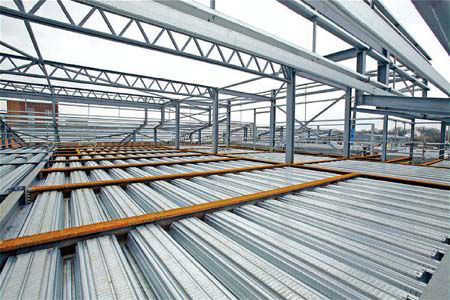Concrete-steel composite structures
Contents |
[edit] Introduction
Structural members that are made up of two or more different materials are known as composite elements. The main benefit of composite elements is that the properties of each material can be combined to form a single unit that performs better overall than its separate constituent parts. The most common form of composite element in construction is a steel-concrete composite, however, other types of composites include; steel-timber, timber-concrete, plastic-concrete, and so on.
As a material, concrete works well in compression, but it has less resistance in tension. Steel, however, is very strong in tension, even when used only in relatively small amounts. Steel-concrete composite elements use concrete's compressive strength alongside steel's resistance to tension, and when tied together this results in a highly efficient and lightweight unit that is commonly used for structures such as multi-storey buildings and bridges.
[edit] Composite slabs
Composite slabs are typically constructed from reinforced concrete cast on top of profiled steel decking, (re-entrant or trapezoidal).
The decking is capable of acting as formwork and a working platform during the construction stage, as well as acting as external reinforcement at the composite stage. Decking is lifted into place in bundles and distributed across the floor area by hand.
Slab depths range from 130 mm upwards. Slabs are most commonly made of concrete because of its mass and stiffness which can be used to reduce the floor's deflections and vibrations, and achieve the necessary fire protection and thermal storage. Steel is often used as the supporting system underneath the slab due to its superior strength-weight and stiffness-weight ratio and ease of handling.
Re-entrant or trapezoidal decking is usually 50-60 mm deep and can span around 3 m unsupported. Trapezoidal profiles of 80 mm deep can span around 4.5 m unsupported. Deep decking is trapezoidal decking that is over 200 mm deep, and if required, additional reinforcement may be placed in the decking troughs. Deep decking can span around 6 m unsupported.
Galvanised steel is used for the decking and is usually around 1 mm thick. To avoid local buckling, stiffeners may be used to stiffen the upper flange and support hangers for relatively lightweight items to be suspended from the soffit. Dimples known as embossments are rolled onto the decking profile which trap the concrete around the re-entrant parts of the profile and allow for interlocking.
Where openings are required in composite slabs these are best formed at the construction stage as opposed to having to cut out sections of concrete. Up to 300 sq. mm openings do not need additional provisions, but up to 700 sq. mm require additional local reinforcement around the opening. If openings are in excess of 700 sq. mm, trimming steel can be used as support.
[edit] Composite beams
[edit] Downstand beam
A downstand beam is connected to a composite slab by the use of through-deck welded shear studs. Alternatively, a precast concrete slab sits on top of the steel beam's top flange. The effective span range is around 6-12 m. Other variations on downstand beams can reach spans of 20 m or more.
[edit] Shallow floors
Shallow floors are where the main part of the steel section is within the concrete slab depth, and can be used for a span range of around 4-9 m. As opposed to downstand beams, the slab sits on the upper surface of the bottom flange instead of the upper surface of the top flange, with a key consideration being the torsion that is applied to the beam. The slab may be either in situ concrete on deep steel decking, usually around 225 mm, or precast concrete.
The benefits of shallow floors are that since the slabs and beams are placed within the same zone, there are none of the interruptions found with downstand beams, and there is often no need for additional fire protection.
[edit] Composite columns
Composite columns can have high strength for a relatively small cross-sectional area, meaning that useable floor space can be maximised. There are several different types of composite column; the most common being a hollow section steel tube which is filled with concrete; or an open steel section encased in concrete. The concrete infill adds to the compression resistance of the steel section, preventing the steel from buckling. Its fire resistant properties can permit the column to be left unprotected or only lightly protected.
Rectangular and circular hollow sections are most commonly used, although rectangular sections are beneficial for being having flat faces suitable for end plate beam-to-column connections. However, fin plates can be used for rectangular and circular shapes.
NB See also: Composite classical order.
[edit] Standards
The design of composite beams and composite slabs (for buildings) are covered by BS EN 1994-1-1. Composite slabs with profiled steel sheeting are designed to BS 5950-4, while the profiled decking used for those slabs is designed to BS EN 1993-1-3.
[edit] Related articles on Designing Buildings
- Architectural concrete.
- Braced frame.
- Composites.
- Concrete.
- Concrete vs. steel.
- Design of durable concrete structures.
- Galvanised steel.
- Precast concrete.
- Prestressed concrete.
- Rebar.
- Reinforced concrete.
- Smart concrete.
- Steel frame.
- Structural steelwork.
- Superstructure.
- Tube structural system.
- Types of steel.
- Weathering steel.
- What will happen if we use too much rebar in concrete?
[edit] External sources
- 'Building Construction Handbook' (12th ed.), R. CHUDLEY, R. GREENO, K.,KOVAC (Routledge, 2020).
- Steelconstruction - Composite construction
Featured articles and news
Architects, architecture, buildings, and inspiration in film
The close ties between makers and the movies, with our long list of suggested viewing.
SELECT three-point plan for action issued to MSPs
Call for Scottish regulation, green skills and recognition of electrotechnical industry as part of a manifesto for Scottish Parliamentary elections.
UCEM becomes the University of the Built Environment
Major milestone in its 106-year history, follows recent merger with London School of Architecture (LSE).
Professional practical experience for Architects in training
The long process to transform the nature of education and professional practical experience in the Architecture profession following recent reports.
A people-first approach to retrofit
Moving away from the destructive paradigm of fabric-first.
International Electrician Day, 10 June 2025
Celebrating the role of electrical engineers from André-Marie Amperè, today and for the future.
New guide for clients launched at Houses of Parliament
'There has never been a more important time for clients to step up and ...ask the right questions'
The impact of recycled slate tiles
Innovation across the decades.
EPC changes for existing buildings
Changes and their context as the new RdSAP methodology comes into use from 15 June.
Skills England publishes Sector skills needs assessments
Priority areas relating to the built environment highlighted and described in brief.
BSRIA HVAC Market Watch - May 2025 Edition
Heat Pump Market Outlook: Policy, Performance & Refrigerant Trends for 2025–2028.
Committing to EDI in construction with CIOB
Built Environment professional bodies deepen commitment to EDI with two new signatories: CIAT and CICES.
Government Grenfell progress report at a glance
Line by line recomendation overview, with links to more details.
An engaging and lively review of his professional life.
Sustainable heating for listed buildings
A problem that needs to be approached intelligently.
50th Golden anniversary ECA Edmundson apprentice award
Deadline for entries has been extended to Friday 27 June, so don't miss out!
CIAT at the London Festival of Architecture
Designing for Everyone: Breaking Barriers in Inclusive Architecture.
Mixed reactions to apprenticeship and skills reform 2025
A 'welcome shift' for some and a 'backwards step' for others.

























